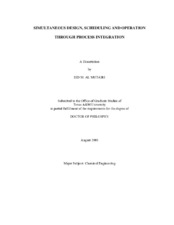| dc.description.abstract | Processing facilities are normally designed with sufficient flexibility to handle nominal
variations. When the process features planned changes in feedstock and products,
scheduling is often used to optimize process operation. The objective of this dissertation
is to develop a new approach to design and scheduling with economic, environmental,
heat integration and inherently safer design objectives. Specifically, this work introduces
a systematic framework and the associated mathematical formulation for simultaneous
process design and scheduling while simultaneously addressing economic,
environmental, heat integration and inherently safer design objectives. Therefore, more
than one type of proper tradeoffs are established between these objectives. The
environmental issues pertaining to the parameterized process retrofitting, scheduling,
and operation strategies are simultaneously considered along with the environmental impact of these changes. Similarly, the design synthesis of heat-exchange networks
(HENs) is addressed in the context of optimizing energy consumption under scheduling
scenarios. Finally, the goal of inherently safer design is simultaneously considered with
the expected schedules of the process. Several optimization formulations are developed
for the projected schedules while allowing design modifications and retrofitting changes.
The modifications and changes include new environmental management units, synthesis
of flexible and optimal HENs, and design of an inherently safer process. Process models
with the appropriate level of relevant details are included in the formulations. A
discretization approach has been adopted to allow for a multiperiod optimization
formulation over a given time horizon. The resulting framework identifies opportunities
for synergism between the economic, environmental, heat integration and inherently
safer design objectives. It also determines points of diminishing return beyond which
tradeoffs between the above mentioned objectives are established. The devised
procedure is illustrated with case studies. | en |


